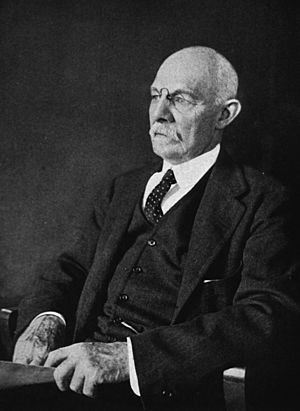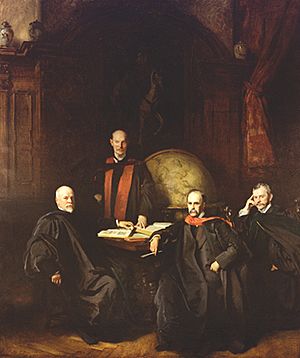William Stewart Halsted facts for kids
Quick facts for kids
William Stewart Halsted
|
|
|---|---|

Halsted in 1922
|
|
| Born | September 23, 1852 New York City, U.S.
|
| Died | September 7, 1922 (aged 69) Baltimore, Maryland, U.S.
|
| Alma mater | Yale University Columbia University College of Physicians and Surgeons |
| Known for |
|
| Scientific career | |
| Fields | Medicine |
| Institutions | Johns Hopkins Hospital |
William Stewart Halsted (September 23, 1852 – September 7, 1922) was an important American surgeon. He taught doctors to be very clean during operations, a method called aseptic technique. He also supported using new medicines to stop pain during surgery, known as anesthetics. Halsted also created new ways to do operations, like the radical mastectomy for breast cancer.
He was one of the "Big Four" founding professors at the famous Johns Hopkins Hospital. The other three were William Osler (Medicine), Howard Atwood Kelly (Gynecology), and William H. Welch (Pathology). Halsted's operating room at Johns Hopkins was a place where new medical discoveries happened. Doctors who worked with him said he had special skills and often got amazing results.
Contents
Early Life and Schooling
William S. Halsted was born on September 23, 1852, in New York City. His family was very rich and had two homes in New York. He was taught at home until he was ten years old. Then, he went to boarding school in Monson, Massachusetts. He didn't like it there and even ran away once.
Later, he went to Phillips Academy and graduated in 1869. After that, he entered Yale College. At Yale, Halsted was very active in sports. He was the captain of the football team and played baseball. He also rowed on the crew team. However, his grades were not very good. Towards the end of his time at Yale, he became interested in medicine. He started going to medical lectures and reading books about the human body.
Becoming a Doctor
After finishing Yale in 1874, Halsted went to Columbia University College of Physicians and Surgeons for medical school. People are not sure why he chose medicine. Some think his father's work with medical groups inspired him. Others believe he just didn't want to join the family business.
Once he started medical school, he became a much better student. He worked with famous doctors like Henry B. Sands and John Call Dalton. In his free time, Halsted also worked in a pharmacy. During his second year, he felt tired and went to Block Island to study and relax. He then took a hard test to get an internship at Bellevue Hospital in New York. Even though the program was usually for doctors who had already graduated, Halsted did so well that he got the internship.
At Bellevue, Halsted spent most of his time in the medical wards. He also helped with some surgeries. Hospitals back then were not very clean. Doctors often bled patients, and surgical tools were not well cared for. Interns even carried buckets of pus from patients. During his internship, Halsted learned about antiseptics. These were special cleaners used to prevent infections, based on a method by Joseph Lister. This made Halsted very interested in fighting infections in hospitals. He finished medical school in 1877, graduating at the top of his class.
Starting His Medical Career
After graduating, Halsted worked at the NewYork–Presbyterian Hospital in April 1878. There, he started using hospital charts to track a patient's temperature, pulse, and breathing. At this hospital, he met William H. Welch, who became a close friend. Halsted left New York Hospital in October 1878.
At that time, there were no special programs in the U.S. to train new doctors for a career in medicine. So, Halsted went to Europe to learn from many famous surgeons and scientists. He learned a lot of new medical ideas and practices that he later brought back to the United States.
Halsted returned to New York in 1880. For the next six years, he worked very hard. Surgery was changing a lot during this time, and Halsted was part of these changes. He worked at many hospitals, including Chambers Street Hospital, Charity Hospital, Bellevue Hospital, and Roosevelt Hospital. At Bellevue, he set up a special tent for surgery where he could practice antiseptic methods.
Halsted also started teaching. He changed how doctors were taught by giving students more hands-on experience. He was a very popular and inspiring teacher. In 1882, he performed one of the first gallbladder operations in the U.S. He even operated on his own mother on her kitchen table to remove seven gallstones, and she recovered completely. Halsted also did one of the first emergency blood transfusions in the U.S. He gave his own blood to his sister after she had given birth and was losing too much blood. These bold operations made Halsted famous as a surgeon.
In 1886, Halsted moved to Baltimore, Maryland. He joined his friend William Welch to help start the new Johns Hopkins Hospital. When Johns Hopkins University Hospital opened in 1889, Halsted became the Head of the Outpatient Department and acting Surgeon. In 1890, he became the Surgeon-in-Chief. In 1892, Halsted, Welch, William Osler, and Howard Atwood Kelly started the Johns Hopkins School of Medicine. Halsted became its first Professor of Surgery. He gave his students, especially those working closely with him, a lot of responsibility. This helped them learn a great deal. During his years at Johns Hopkins, he made many important contributions to surgery.
Major Achievements
Halsted is famous for starting the first formal surgical residency training program in the United States at Johns Hopkins. This program was based on ideas he learned in Europe. It became the model for how doctors are trained today. The program involved an internship, followed by several years as an assistant resident, and then as a house surgeon. This system helped train many future leaders in surgery, like Harvey Williams Cushing and Walter Dandy, who started neurosurgery, and Hugh H. Young, who helped start urology. His training methods spread across the U.S. and greatly changed American medicine.
Halsted believed that cancers spread through the bloodstream. This led him to think that removing a tumor completely would cure the cancer. In 1882, he performed the first radical mastectomy for breast cancer in the U.S. at Roosevelt Hospital. This operation involved removing a lot of breast tissue, including muscles and lymph nodes. It caused significant changes to the body. Halsted presented his findings, showing that this procedure reduced how often cancer came back in the same area. However, today we know that how much cancer has spread before surgery is more important for survival than how much tissue is removed during surgery.
Halsted also developed many surgical techniques to reduce damage to tissues and blood supply. These included new types of tools like forceps, and ways to close wounds. He also worked on surgery for other diseases, such as problems with blood vessels, hernias, and certain types of cancer. He also helped improve anesthesia, which is vital for modern surgery. Halsted created "Halsted's principles," which are still used today. These principles include controlling bleeding, carefully cutting tissues, keeping everything sterile, closing wounds neatly, and handling tissues gently.
In 1889, Halsted also helped bring rubber gloves into the operating room. The main reason for this was to protect the hands of his scrub nurse, Caroline Hampton. She had a skin problem from the strong antiseptics. So, Halsted asked the Goodyear Rubber Company to make special rubber gloves for her. Caroline Hampton later became Halsted's wife. Even though the gloves were first used for protection, they greatly improved how clean operations were, which was later shown by Joseph Colt Bloodgood.
Other achievements included advances in surgery for the thyroid, biliary tract (gallbladder and bile ducts), hernias, and blood vessel problems.
A famous writer named H.L. Mencken thought Halsted was the best doctor in the Johns Hopkins group. Mencken praised Halsted's work, saying he brought a new way of looking at patients. He taught that surgeons must be very careful with tissues. He showed that the body's natural healing powers could help patients. He was against careless cutting and taught that a surgeon must be very cautious. He was also an amazing teacher, and the young doctors he trained became very important in American surgery.
Personal Life
In 1890, Halsted married Caroline Hampton. She was the niece of Wade Hampton III, a former general. They bought a mountain retreat in North Carolina. There, Halsted enjoyed growing dahlias (a type of flower) and studying astronomy. Halsted and his wife did not have any children. He passed away on September 7, 1922, just before his 70th birthday. He died from lung problems after surgery for gallstones.
Medical Terms Named After Halsted
- Halsted's law: This idea says that transplanted tissue will only grow if the body receiving it needs that tissue.
- Halsted's operation I: A surgery for a type of inguinal hernia.
- Halsted's operation II: The radical mastectomy for breast cancer.
- Halsted's sign: A medical sign that can point to breast cancer.
- Halsted's suture: A special type of stitch for wounds that leaves less scarring.
- Halsted mosquito forceps: A small tool used to control bleeding during surgery.
- Halsted ligament: A ligament (a strong band of tissue) in the shoulder area.
See also
 In Spanish: William Halsted para niños
In Spanish: William Halsted para niños
- The Knick



